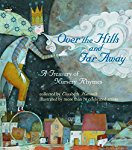I know that children are the ones who are supposed to hope and wish for a snow day, but I have to confess that I hope and wish for them too. There is nothing like taking a day off work to play in the snow with dogs and family members; and to sit toasting toes in front of the fire afterwards. In today's poetry book we meet a little girl who desperately wants a snow day, and her reason for wanting such a day is even more important that having a day off from school.
 Before Morning
Before Morning
 Before Morning
Before Morning
Joyce Sidman
Illustrated by Beth Krommes
Poetry Picture Book
For ages 5 to 7
Houghton Mifflin Harcourt, 2016, 978-0-547-97917-5
A little girl and her mother arrive home on a cold winter
night. Dinner is on the table and all should be well, but the little girl is
sad. Soon her mother is going to be leaving for the airport where her plane and
crew await her. She is a pilot and her job means that she has to leave home for
days at a time.
The little girl
hides her mother’s pilot hat, but has to give it back. Her mother has to go to
work and there is nothing that can be done about it. While the little girl
sleeps “In the deep woolen dark” that is now freckled with snowflakes, the
pilot packs her bags and leaves the house. What the mother does not know is
that her daughter has sent a wish up into the night, a wish asking for the snow
to come and “Let the air turn to feathers, / the earth turn to sugar.” The
little girl wants everything to be “swaddled” in a blanket of snow.
The hope is that
the snow will be heavy enough that “urgent plans founder,” and planes will be
grounded so that her mother will be able to come home to her.
With gorgeous
scratchboard art what is rich in textures, and a magical rhyming text that is
beautiful in its minimalism, this unique picture book celebrates the power of a
child’s wish.







